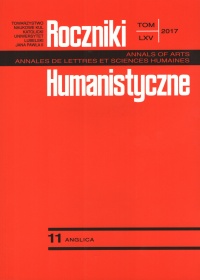Analizowalność i kompozycjonalność gier słownych
Abstract
We apply the notions of analysability and compositionality (as proposed by Langacker 1987; 1991; 2000a; 2000b; 2008) to the study of wordplay. Our claim is that some instances of such creative use of language require to “decompose” non-compositional units, i.e. render non-composite structures composite so that they can be thought of as being assembled from their components in accordance with regular compositional principles. This sort of decomposition allows for alternative composite arrangements (catalogue—cat-alogue, insects—in-sects, penguin—pen-guin, etc.) to emerge. It must be highlighted that the reader comprehends the conventional meaning in the first place and it is only then that the context of the usage-event forces a plausible re-interpretation.
What is more, it appears that the notion of analysability can be also applied to wordplay based on idiomatic language (Gibbs 2010). It commonly involves some underlying conceptual metaphor and metonymy as its motivational force, hence this sort of language may be conceptualized on two planes, a virtual one and an actual one, where the profile shift between the two (when placed in the context suiting both planes) may foster wordplay.
Finally, since the values of analysability/compositionality are of a gradable character, it is possible to establish the A/C hierarchy for wordplay, which starts with bigger chunks of language set in context, i.e. discourse units, and goes through sentence and phrasal units, down to compounds and blends etc. Consequently, it seems plausible to represent analysability/compositionality of wordplay as a similar sort of continuum.
References
Attardo, Salvatore, and Victor Raskin. 1991. “Script theory revisited: joke similarity and joke representation model.” Humor, 43, pp. 293–347.
Attardo, Salvatore, and Victor Raskin. 1994. Linguistic Theories of Humor. Berlin-New York: Mouton de Gruyter.
Bybee, Joan. 2014. Analytic and holistic processing in the development of constructions. In Language in interaction: Studies in honor of Eve V. Clark, edited by Inbal Arnon, Marisa Casillas, Chigusa Kurumada, and Bruno Estigarribia, Amsterdam and Philadelphia: John Benjamins Publishing Co., pp. 303–13.
Chiaro, Delia. 1996. The Language of Jokes: Analyzing Verbal Play. London: Routledge.
Dynel, Marta. 2013. “Humorous phenomena in dramatic discourse.” European Journal of Humour Research, 11, 22–60.
Ermida, Isabel. 2008. The Language of Comic Narratives: Humour Construction in Short Stories. Berlin, New York: Mouton de Gruyter.
Frege, Gottlob. 1952. “Über Sinn und Bedeutung: Zeitschrift für Philosophie und philosophische Kritik.” Translated as “On Sense and Reference.” In Translations from the Philosophical Writings of Gottlob Frege, edited by Peter Geach and Max Black. Oxford: Blackwell, 56–78.
Gibbs, Raymond, and Nandini Nayak. 1989. Psycholinguistic studies on the syntactic behavior of idioms. Berlin/New York: Walter de Gruyter.
Gibbs, Raymond, and Nandini Nayak. 2006. “Metaphor interpretation as embodied simulation.” Mind & Language 21, pp. 434–58.
Gibbs, Raymond. 2010. “Stability and variation in linguistic pragmatics.” Pragmatics and Society 1, pp. 32–49.
Kardela, Henryk. 1992. “Gramatyka kognitywna jako globalna teoria języka.” In Język a Kultura. Tom 8, edited by Iwona Nowakowska-Kempna. Wrocław: Wiedza o Kulturze.
Kardela, Henryk. 2004. “Semasiology and Onomasiology in Cognitive Morphology. An A/D Asymmetry Account.” In Perspectives on Language, edited by Henryk Kardela, William J. Sullivan, and Adam Głaz, Lublin: Wydawnictwo Uniwersytetu Marii Curie-Skłodowskiej, pp. 109–122.
Kardela, Henryk. 2006. “The dynamicity of categorisation.” In At the Crossroads of Linguistic Sciences, edited by Piotr P. Chruszczewski, Michał Garcarz, and Tomasz P. Górski. Wrocław: Tertium, pp. 183–202.
Kardela, Henryk. 2010. “Fakty hipotetyczne: kognitywna analiza twórczego wykorzystania języka na stronach internetowych Muzeum IV RP.” In Język IV Rzeczpospolitej, edited by Maciej Czerwiński, Paweł Nowak, and Renata Przybylska, Lublin: Wydawnictwo Uniwersytetu Marii Curie-Skłodowskiej, pp. 401–17.
Kardela, Henryk. 2012. “Words in Context: a Cognitive Grammar Perspective.” In Words in Contexts: from Linguistic Forms to Literary Functions, edited by Przemysław Łozowski and Anna Włodarczyk-Stachurska. Radom: Technical University of Radom, pp. 91–107.
Krikmann, Arvo. 2006. “Contemporary linguistic theories of humour.” Folklore 33, pp. 27–57.
Kwiatkowska, Alina. 1998. “The spatial basis of cognition and language: theoretical implications.” In Lexical semantics, Cognition and Philosophy, edited by Barbara Lewandowska-Tomaszczyk. Łódź: Łódź University Press, pp. 195–202.
Lakoff, George, and Mark Johnson. 1980. Metaphors We Live By. Chicago: University of Chicago Press.
Lakoff, George, and Mark Johnson. 1999. Philosophy in the flesh: The embodied mind and its challenge to western thought. New York: Basic Books.
Lampert, Martina, and Günter Lampert. 2010. “Word formation or word formation? The formation of complex words in cognitive linguistics.” In Cognitive perspectives on word formation, edited by Alexander Onysko and Sasha Michel. New York: Walter de Gruyter, 29–74.
Langacker, Ronald. 1987. Foundations of Cognitive Grammar. Vol. I. Stanford, CA: Stanford University Press.
Langacker, Ronald. 1991. Foundations of Cognitive Grammar. Vol. II. Stanford, CA: Stanford University Press.
Langacker, Ronald. 2000. Grammar and Conceptualisation. Berlin, New York: Mouton de Gruyter.
Langacker, Ronald. 2008. Cognitive grammar: A basic introduction. Oxford: Oxford University Press.
Langacker, Ronald. 2009. “Constructions and constructional meaning.” In New Directions in Cognitive Linguistics, edited by Vyvyan Evans and Stephanie Pourcel. Amsterdam and Philadelphia: John Benjamins Publishing.
Lederer, Richard. 1998. Crazy English. New York: Gallery Books.
Noël, Dirk. 2007. “Diachronic construction grammar and grammaticalization theory.” Functions of Language 14, 2, pp. 177–202.
Nunberg, Geoffrey, Ivan Sag, and Thomas Wasow. 1994. “Idioms.” Language 70, pp. 491–538.
Partington, Alan. 1998. Patterns and Meanings. Using Corpora for English Language Teaching and Research. Amsterdam: John Benjamins Publishing Company.
Pepicello, William. 1989. “Ambiguity in verbal and visual riddles.” Humor 2, pp. 207–15.
Raskin, Victor. 1985. Semantic mechanisms of Humor. Dordrech, Boston Lancaster: Reidel Publishing Company.
Tuggy, David. 2006. “Schematic network: Ambiguity, polysemy, and vagueness.” In Cognitive linguistics: Basic Readings, edited by Dirk Geeraerts. Berlin: Mouton de Gruyter.
Talmy, Leonard. 2007. “Attention phenomena.” In Oxford Handbook of Cognitive Linguistics, edited by Dirk Geeraerts & Hubert Cuyckens. Oxford: Oxford University Press.
Wilson, Nicole, and Raymond Gibbs. 2007. “Real and Imagined Body Movement Primes Metaphor Comprehension.” Cognitive Science, 31, pp. 721–31.
Copyright (c) 2017 Roczniki Humanistyczne

This work is licensed under a Creative Commons Attribution-NonCommercial-NoDerivatives 4.0 International License.





